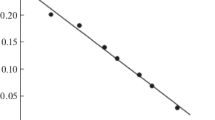Abstract
Adriamycin (ADR) induces nonimmunological and noncytotoxic histamine release from peritoneal and pleural rat mast cells. This secretion is unaffected by the pretreatment with pertussis toxin, cholera toxin and benzalkonium chloride. Histamine release induced by compound 48/80, was markedly inhibited by pertussis toxin, cholera toxin, benzalkonium chloride and neuraminidase. The ADR dose-response curve is significantly shifted to the right when cells were preincubated with the unspecific phosphodiesterase inhibitor IBMX. The activation of protein kinase C (PKC) with the phorbol esther TPA increases the response to ADR, while PKC inhibition with trifluoperazine decreases histamine release. The pretreatment of mast cells with okadaic acid did not modify the response to ADR. these results suggests that ADR elicits histamine release with a mechanism notably different from compound 48/80.
Similar content being viewed by others
References
T. W. Martin and D. Lagunoff, Ed.,Mast Cell Secretion. Cell Biology of the Secretory Process, Basel Karger 1984.
L. M. Botana, E. Arnaez, M. R. Vieytes, A. Alfonso, M. J. Bujan, M. C. Louzao and A. Cabado,Non-immunological release of histamine from rat mast cells elicited by antineoplastic agents. Cancer Chemother. Pharmacol.29, 495–498 (1992).
L. M. Botana, E. Arnaez, M. R. Vieytes, A. Alfonso and M. C. Louzao,Nonimmunological release of histamine from rat mast cells elicited by antineoplastic agents: Effect of drug combinations. Cancer Chemother. Pharmacol.30, 487–490 (1992).
E. Arnaez, A. Alfonso, M. Estevez, M. R. Vieytes, M. C. Louzao and L. M. Botana,Effect of purification, theophylline and sodium fluoride on histamine release produced by antineoplastic drugs on rat mast cells. A distinctive mechanism of action for carboplatin. Biochem. Pharmacol.44, 533–538 (1992).
B. Diamant,New insights into the mechanisms of histamine release from rat peritoneal mast cells. Chem. Immunol.49, 142–172 (1990).
K. F. Bartoli, G. Decorti, L. Candussio and L. Baldini,Effect of phosphatidylserine on adriamycin uptake and histamine release in rat peritoneal mast cells. Pharmacol. Res.24, 455–456 (1989).
T. R. Tritton,Cell Surface Actions of Adriamycin. Pharmacol. Ther.49, 293–309 (1991).
G. Decorti, F. B. Klugmann, L. Candussio, A. Furlani, V. Scarcia and L. Baldini,Uptake of adriamycin by rat and mouse mast cells and correlation with histamine release. Cancer Res.49, 1921–1926 (1989).
N. Eleno, L. M. Botana and J. Espinosa,Veratridine elicits histamine release and promotes calcium uptake in mast cells. Biochem. Pharmacol.37, 3523–3525 (1988).
P. A. Shore,Fluorometric assay of histamine. Meth. Enz.XVII, 842–845 (1971).
M. D. Estévez, M. R. Vieytes, M. C. Louzao and L. M. Botana,Effect of okadaic acid on immunologic and non-immunologic histamine release in rat mast cells. Biochem. Pharmacol.47, 591–593 (1994).
L. M. Botana, J. Espinosa and O. M. P. Fernandez, [Response of pleural and peritoneal mastocyte populations in the rat to agents with different mechanisms of action]. Rev. Esp. Fisiol.42, 449–453 (1986).
G. Decorti, K. F. Bartoli, L. Candussio and L. Baldini,Characterization of histamine secretion induced by anthracyclines in rat peritoneal mast cells. Biochem. Pharmacol.35, 1939–1942 (1986).
T. Johansen,Estimation of adenosine triphosphate utilization of rat mast cells during and after anaphylactic histamine secretion. FEBS Lett.268, 103–106 (1990).
S. Cockcroft, T. W. Howell and B. D. Gomperts,Two G-proteins act in series to control stimulus-secretion coupling in mast cells: use of neomycin to distinguish between G-proteins controlling polyphosphoinositide phosphodiesterase and exocytosis. J. Cell Biol.105, 2745–2750 (1987).
H. Saito, F. Okajima, T. F. Molski, R. I. Shaafi, M. Ui and T. Ishizaka,Effects of ADP-ribosylation of GTP-binding protein by pertussis toxin on immunoglobulin E-dependent and-independent histamine release from mast cells and basophils. J. Immunol.138, 3927–3934 (1987).
M. Aridor, L. M. Traub and R. Sagi-Eisenberg,Exocytosis in mast cells by basic secretagogues: evidence for direct activation of GTP-binding proteins. J. Cell Biol.111, 909–917 (1990).
M. A. Mulkins, N. G. May and R. A. Lewis,Mycophenolic acid inhibits the degranulation of rat peritoneal mast cells. Cellular Immunol.141, 508–517 (1992).
T. Ishizaka,Biochemical analysis of triggering signals induced by bridging of IgE receptors. Fed. Proc.41, 17–21 (1982).
J. A. Warner, K. B. Yancey and D. W. J. MacGlashan,The effect of pertussis toxin on mediator release from human basophils. J. Immunol.139, 161–165 (1987).
M. Mousli, C. Bronner, Y. Landry, J. Bockaert and B. Rouot,Direct activation of GTP-binding regulatory proteins (G-proteins) by substance P and compound 48/80. FEBS Lett.259, 260–262 (1990).
J. L. Bueb, M. Mousli, C. Bronner, B. Rouot and Y. Landry,Activation of Gi-like proteins, a receptor-independent effect of kinins in mast cells. Mol. Pharmacol.38, 816–822 (1990).
K. Saeki, S. Ikeda and M. Nishibori,Calcium requirement for the inhibition by theophylline of histamine release from mast cells. Life Sci.32, 2973–2980 (1983).
K. P. Huang,The mechanism of protein kinase C activation. Trends Neurosci.12, 425–432 (1989).
G. Powis,Signalling Targets for Anticancer Drug Development. Trends Pharmacol. Sci.12, 188–194 (1991).
R. Hoffman and E. S. Newlands,Role of protein kinase C in adriamycin-induced erythroid differentiation of K562 cells. Cancer Chemother. Pharmacol.28, 102–104 (1991).
A. S. Heiman and F. T. Crews,Characterization of the effects of phorbol esters on rat mast cell secretion. J. Immunol.134, 548–555 (1985).
L. M. Botana, A. Alfonso, M. A. Botana, M. R. Vieytes, M. C. Louzao and A. G. Cabado,Influence of protein kinase C, cAMP and phosphatase activity on histamine release produced by compound 48/80 and sodium fluoride on rat mast cells. Agents and Actions37, 1–7 (1992).
W. N. Hait and D. T. Aftab,Rational design and preclinical pharmacology of drugs for reversing multidrug resistance. Biochem. Pharmacol.43, 103–107 (1992).
K. Dano,Active outward transport ofdaunomycin. Biochem. Biophys. Acta323 (1973).
P. Cohen, C. F. Holmes and Y. Tsukitani,Okadaic acid: A new probe for the study of cellular regulation. Trends Biochem. Sci.15, 98–102 (1990).
M. D. Estévez, M. R. Vieytes, A. Alfonso, R. Riguera and L. M. Botana,Study of the activation mechanism of human GRF (1–29) NH 2 on rat mast cell histamine release. (Submitted)
Author information
Authors and Affiliations
Rights and permissions
About this article
Cite this article
Estévez, M.D., Vieytes, M.R. & Botana, L.M. Study of the activation mechanism of adriamycin on rat mast cells. Agents and Actions 42, 86–91 (1994). https://doi.org/10.1007/BF01983470
Received:
Accepted:
Issue Date:
DOI: https://doi.org/10.1007/BF01983470



